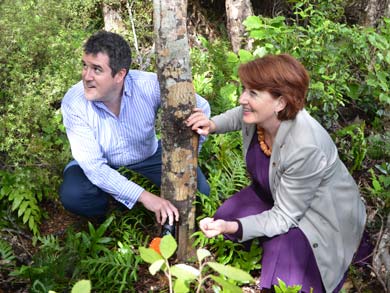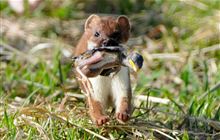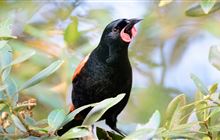Kiwi safe-zone doubled in Rimutaka ranges
Archived content: This media release was accurate on the date of publication.
Introduction
1,200 new stoat traps have been installed in Rimutaka Forest Park.Date: 25 January 2017

Minister of Conservation Maggie Barry and MP Chris Bishop install the first of 1,200 new stoat traps in the Rimutaka Forest Park
Today the Minister of Conservation, Hon. Maggie Barry installed the first of 1,200 new stoat traps in Rimutaka Forest Park.
Volunteer groups will entirely manage the new predator control scheme, more than doubling the current safe-zone for kiwi to 7,000 ha. The area crosses the popular Catchpool and Orongorongo valleys which welcome over 30,000 visitors a year.
The self-resetting traps have been funded by Department of Conservation and contribute to the Government’s ambitious Predator Free 2050 project. The aim is to rid New Zealand of introduced rats, stoats and possums through collaborative large-scale predator-control, and increase support for community-led projects.
“This is Predator Free 2050 in action,” said Minister Barry, “Joining forces with the community and each contributing our different strengths enables us to achieve big wins together, such as reversing kiwi decline in the wild.”
Rimutaka Forest Park Trust and MOA Conservation Trust members currently check 90 kilometres of trap lines in the rugged hill country east of Wellington and are keen to expand their mandate.
“We are thrilled to be growing the trap network – and the protection for kiwi. Stoats kill many wild kiwi chicks. This year due to the predicted mast event we have had to collect eggs, hatch them safely elsewhere and return the chicks when they are big enough to defend themselves,” says Melody Mclaughlin from, Rimutaka Forest Park Trust who have worked in the park for nearly 30 years.
“The collaboration with MOA on this project is the springboard to the next stage of catchment-wide predator control and huge gains in the protection of some amazing species.”
Native birds such as kaka are expanding from Wellington – a safe haven in the Rimutaka will provide a network of protection alongside Zealandia and Kapiti Island.
The 1,200 new traps designed by Wellington company Goodnature utilise the latest lure technology – they automatically reset after each kill and pump out fresh lure, reducing work for volunteers from monthly to 6-monthly checks.
Minister Barry says innovation is critical in ridding New Zealand of predators; “New Zealand is a world leader in conservation technology and research. The Government is focusing on developing breakthrough techniques and is supporting Goodnature and others to ensure we have the right tools to make Predator Free 2050 a reality.”
MOA Conservation Trust, a partner in the trap project, was formed by a groups of friends in 2014 and Jamie McNaught says they share DOC’s aspirations.
“This new network is a step towards the ‘Predator Free South of the North’ vision – a continuous predator control network from coast to coast across Wellington and Wairarapa,” says Mr McNaught. “MOA is new on the scene but we’re arrived at the right time – through active collaboration with Rimutaka Forest Park Trust, DOC, Greater Wellington Regional Council, OSPRI and Predator Free Wellington the future is looking bright.”
Contact
Lee Barry, Community Ranger, Kapiti Wellington
Phone: + 64 4 470 8439
Mobile: +64 21 052 5857
Email: lbarry@doc.govt.nz



